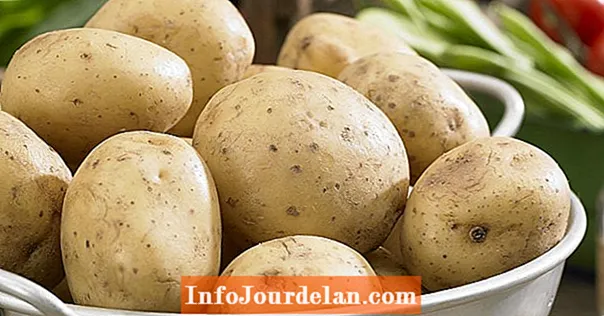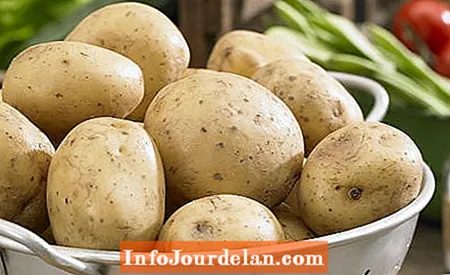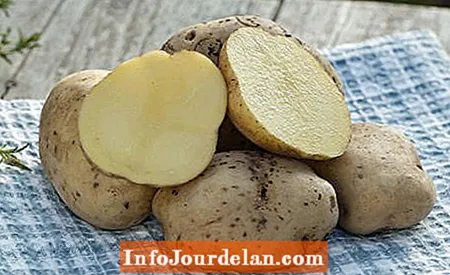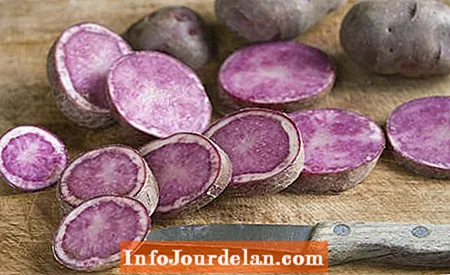
Content
- Recommended editorial content
- Red potatoes: the best varieties for the garden
- Blue potatoes: the best varieties for the garden
Floury potatoes, with their floury and fluffy consistency, are ideal for purees or dumplings. Read here which varieties are suitable for growing in your own garden.

Floury potatoes have - as their name suggests - a slightly floury consistency. When cooking, the shell bursts and they disintegrate quickly. This is due to the high starch and low moisture content of the tubers: floury potatoes contain more starch than waxy potatoes and are rather dry and coarse-grained. Since they can be easily mashed with a fork, they are ideal for preparing purees, gnocchi and dumplings.
When labeling the various types of potatoes, a distinction is made between the three types of cooking waxy (A), predominantly waxy (B) and floury (C). However, the assignment is not always that clear: Depending on the weather, soil and form of cultivation, the starch content of a variety can be different. The pre-germination of the potatoes, for example, helps to achieve a high starch content early on. Some mid-early and mid-late varieties only develop their special cooking type after a certain amount of storage.
In this episode of our podcast "Grünstadtmenschen" you can hear everything you have to consider when growing potatoes and which varieties our editors Nicole Edler and Folkert Siemens like best. Have a listen right now!
Recommended editorial content
Matching the content, you will find external content from Spotify here. Due to your tracking setting, the technical representation is not possible. By clicking on "Show content", you consent to external content from this service being displayed to you with immediate effect.
You can find information in our data protection declaration. You can deactivate the activated functions via the privacy settings in the footer.
Why are some types of potato floury?Whether a type of potato is floury or waxy depends primarily on the starch content. Rule of thumb: the more starch the tuber contains, the more floury it is. The starch content depends primarily on the respective potato variety, but also on various location factors and growing conditions.
‘Ackersegen’ arose from a cross between the Hindenburg ’and Very earliest yellow’ varieties and has been on the market since 1929. Characteristics of the late-ripening, floury potatoes are a yellow, slightly moistened skin, flat eyes and yellow flesh. The plants are only slightly susceptible to scab and late blight.

‘Adretta’ is a floury potato variety that was bred in the GDR in 1975 and ripens medium early. The round tubers are characterized by an ocher-colored shell, medium-deep eyes and light yellow to yellow flesh. They also have a fine taste and are easy to store.
In 1990 the slightly floury cooking potato ‘Afra’ was approved in Germany. The oval to round tubers are yellow-fleshed, have a slightly rough skin and a pleasantly strong aroma. The plants thrive well in sunny places - they can even cope with a dry and hot climate.
With ‘Agria’, the consistency can vary greatly depending on the weather and location. The predominantly floury potatoes are yellow-fleshed and have a fine potato aroma. Due to their high starch content, they are good for mashed potatoes, but they are also popular for french fries and chips.
The floury potato variety ‘Augusta’ used to be used as a fodder potato and to use starch. The round, somewhat misshapen tubers have a yellow skin, dark yellow flesh and deep eyes. Thanks to their floury, dry and grainy consistency, they are very suitable for dumplings and soups.
‘Arran Victory’ is originally from Scotland. The late-ripening potato variety was created at the beginning of the 20th century - it is therefore one of the old potato varieties. The round oval tubers have a purple skin, deep eyes and light yellow flesh. The taste of the floury potatoes is reminiscent of chestnuts.

The potato variety ‘Bintje’, which was bred in the Netherlands and came onto the market in 1910, ripens mid-early to mid-late. The tubers have a long oval shape, a yellow, smooth skin, medium-deep eyes and light yellow flesh. Depending on the growing area, the potatoes are floury or mainly waxy - they are therefore often used for soups, but also for baked or boiled potatoes. The plants are quite drought tolerant.
‘Finka’ is also a slightly floury to predominantly waxy variety. It was brought onto the market in 2011 by the Böhm potato grower. The tubers ripen very early, with both the skin and the flesh being yellow in color. With a good supply of water and nutrients, the plants form many bulbs of the same size.
 Kitchen gardens
Kitchen gardens
Red potatoes: the best varieties for the garden
Red potatoes are an asset to many dishes. Here you will find recommended varieties for growing in your own garden. Learn more Kitchen gardens
Kitchen gardens
Blue potatoes: the best varieties for the garden
Blue potatoes are rare delicacies that are wonderful to grow in your own garden. An overview of recommended varieties can be found here. Learn moreAnother recommended type of potato for growing in your own garden is ‘Gala’, which was approved in Germany in 2002. Even if the plants only develop a few leaves, they are very productive. The long-oval tubers have a yellow skin and yellow pulp. If you let them ripen optimally, their consistency is nice and floury.
The old potato variety ‘Highland Burgundy Red’ probably comes from Scotland and is one of the red potatoes. Not only does the shell of the long oval tubers have a dark red color: the meat also has a red glow with a white rind. The floury potatoes are suitable for boiled or fried potatoes and cold also for potato salad.

‘Lilly’ is a medium-early potato variety whose tubers have a beautiful, evenly yellow skin and deep yellow flesh. The floury potatoes hardly darken when cooked and do not disintegrate as quickly. Further advantages: The potato plants have high tolerances towards silver scab and tuber rot.
‘Mehlige Mühlviertler’ already has their cooking characteristics in their name. The floury-cooking variety originally comes from Austria and is traditionally used in the Austrian-Bohemian dumpling cuisine. The tubers ripen late, have a yellow skin, light yellow flesh and deep eyes. In addition to dumplings, mashed potatoes and stews can also be prepared well with the floury potatoes.
Another medium-late, floury potato is ‘Melody’. The relatively young breed was voted "Thuringian Potato of the Year" in 2013. The yellow-skinned and yellow-fleshed potatoes can be stored well and are of solid food quality. However, the variety is only recommended for well-supplied soils, as it quickly becomes iron-stained in unfavorable soil conditions.
There are also some floury potatoes among the blue potatoes, such as the ‘Odenwälder Blaue’. The German potato variety probably originated in 1908. The rounded tubers have a dark purple skin, deep eyes and creamy white flesh. They ripen late and have a floury and spicy taste.
The ‘Black Hungarian’, an old Hungarian country variety, is reminiscent of the Odenwald blue ’with its dark skin and light flesh. However, the tubers are smaller and more oval shaped. The medium-early potato variety is robust and quite productive.
There are a few things you can do wrong with planting potatoes. In this practical video with gardening editor Dieke van Dieken, you can find out what you can do when planting to achieve an optimal harvest
Credits: MSG / CreativeUnit / Camera + Editing: Fabian Heckle